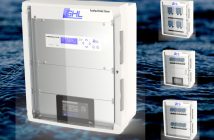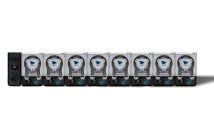This is Part 3 of a Multi-Part Article on aquarium filtration and the basic anatomy of a saltwater aquarium. So be sure to stay tuned for the remainder of the article…
In Anatomy of a Reef Aquarium – Part 1, we discussed setting a budget for your reef aquarium build and determining the type of livestock desired. We followed part one with Anatomy of a Reef Aquarium – Part 2 discussing the shape of the aquarium as well as the material it is made out of. This article will be dedicated strictly to aquarium lighting.
Corals make their food in the same manner that plants do, via photosynthesis. Photosynthesis, in a nutshell, is the process of converting light energy into chemical energy that plants, bacteria, and algae can use to drive the fixation of carbon dioxide into complex organic molecules such as sugars. These sugars, produced by the photosynthetic algae (zooxanthellae) living in the coral’s tissues, are the nutrients needed for coral survival. Up to 90% of a coral’s nutritional intake can come from photosynthetically derived sugars. So, sunlight is the most important source of food for most corals. One method used to measure how effective aquarium lighting is at providing corals with the appropriate amount of light energy has been the measuring of Photosynthetically Active Radiation, abbreviated PAR. This measure designates the spectral range of solar light that photosynthetic organisms are able to use in the process of photosynthesis and is a key indicator of how well our lighting systems work on our aquariums. With this in mind, it is wise to pick out the appropriate lighting system for your reef aquarium, otherwise your livestock might not thrive.
There are many types of aquarium lighting, each with their own benefits and drawbacks. In the remainder of the article, I will describe fluorescent lighting, metal halide lighting, and LED lighting.
Fluorescent Lighting
The fluorescent lighting category includes a vast array of lighting systems. These include, but are not limited to: standard output fluorescent lighting (T8 or T12), compact fluorescent lighting (also known as power compacts), very high output (VHO) fluorescent, and T5HO fluorescent.
Standard output fluorescent lighting is typically found in two sizes, T8 and T12 (indication of bulb diameter). These two sizes are very cheap and come in a variety of lengths, which make them fairly appealing to the budget-minded aquarium keeper. The major drawback to this lighting system is the output. These bulbs put out a very minimal amount of PAR and cannot penetrate the water enough to deliver enough energy to the corals.
Compact fluorescent lighting (power compacts) are very widespread in the reef aquarium community. They come standard on almost all brands of the all-in-one nano aquariums and are perfect lights for most soft corals and other low light corals. But there are some substantial drawbacks. For one, they come in a variety of lengths, wattages, and pin configurations which it very difficult to replace bulbs when they burn out. A second drawback is that these bulbs run very hot, and consequently need to be replaced every 6-8 months due to a shift in spectrum that occurs with older bulbs. Lastly, these bulbs do not put out enough PAR in order to adequately keep harder corals like Acropora species. Some Montipora species can survive under these lights, but I would not subject them to this low level of light long term.
Very High Output lighting (VHO) are yet another type of fluorescent lighting that is fairly frequently used over saltwater aquariums. They come in various lengths, up to 6 feet long, and have internal reflectors built right in. The put out a bit more PAR than the previously mentioned bulbs and have been around for a long time. Despite this, VHO systems are starting to go the way of the dinosaurs, at least in terms of being an aquarium’s primary source of lighting. Reef keepers now flock toward T5HO as their fluorescent light of choice, though VHO are still strong candidates for supplemental lighting due to their spectacular coloration emitted from their actinic bulbs.
T5HO is at the pinnacle of the fluorescent lighting industry, as far as aquariums are concerned. The bulbs have a small diameter and put out more useable light per watt than the other fluorescent bulbs mentioned in this list. They come in a growing variety of lengths from 18 inches to five feet and have an effective life of at least a year and a half, though I’ve run them longer without issue. T5HO also come in a huge variety of colors, giving the reef aquarium keeper plenty of options and allowing for a complete customization of the color. Another benefit to these bulbs is that they can provide adequately illumination for any coral or clam. T5HO is becoming a very popular lighting system for hard coral dominated reef tanks and even metal halide users are making the switch more and more. This is due to the fact that T5HO run cooler, use less energy, bulbs last longer and are cheaper, cause less evaporation, give better color, and put out a comparable amount of light to metal halides. The one downside that I have experienced is the fact that T5HO bulbs don’t come in six foot lengths, which is somewhat of a pain for people with six foot long tanks. All things considered though, T5HO is the best lighting system for any aquarium.
Metal Halide Lighting
Metal halides are a very popular choice for illuminating reef aquariums. They have been around for a long time and still hold a large portion of the market. This is due for several reasons. First of all, metal halides come in several wattages and multiple styles. For example, the common wattages for aquarium applications are 70 watts, 150 watts, 175 watts, 250 watts, and 400 watts. As for styles, the two commonly used types are single-ended (SE) and double-ended (DE). There are multiple pros and cons of each style, but discussing this now would require a whole other article altogether. Another positive for metal halides is the variety of bulb colors available. Bulbs come on colors ranging from 6500K (Kelvin or color temperature), which is a yellow bulb, all the way up to 22000K, which is a very blue bulb. Additionally, metal halides cast a “shimmer effect” in the aquarium, which is a “make or break” for some people. This is due to the light being emitted from a single point source as opposed to coming from the entire length of the bulb. The “shimmer effect” casts varying lines across everything in the aquarium and give it a very natural look.
Despite all the advantages of using metal halides, there are multiple downsides. For one, the bulbs and the rest of the equipment are all very expensive. Some bulbs even retail for over $100, or the equivalent of about four T5HO bulbs. Additionally, those expensive bulbs have a very short effective life. Most people suggest changing metal halides every year, but others say that 6-8 months is the maximum life on them. Another issue, and probably one of the greatest, is energy usage and heat given off by these lights. Metal halides use a lot of energy, consequently putting out quite a bit of heat. They put out so much heat that a chiller will probably be required to keep aquarium water temperatures within an acceptable range.
LED Lighting
Light Emitting Diodes, or LEDs, are fairly new to the aquarium hobby and have already created quite a stir. They are very energy efficient and the bulbs can last a very long time before needing to be replaced. Additionally, they put out very little heat compared to other lighting systems.
But before I rave about LED lighting, there is one huge and fatal flaw. There is a company with no relation to the aquarium industry that has put a patent on using LED lighting over aquariums. And according to patent attorneys, building a do-it-yourself LED lighting system or even using a light fixture manufactured prior to the patent’s filing are considered patent infringement and against the law. It is a huge blow to the aquarium community and LED supporters, but new technologies will find their way around these silly patents.
Wrapping things up, the lighting system you choose for your aquarium is very important. Research your future coral’s lighting requirements before you purchase a light setup. In my experience though, T5HO is the best available aquarium lighting system on the market as it provides an excellent source of light for any type of aquarium coral or other photosynthetic livestock.
This concludes part 3 of our Anatomy of a Saltwater Reef Aquarium Series. In part 4 we’ll discuss filtration equipment such as protein skimmers, ozonizers, and UV sterilizers.






Pingback: Anatomy of a Reef Aquarium - Part 4 | AquaNerd()